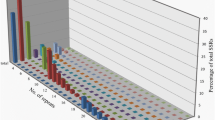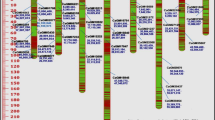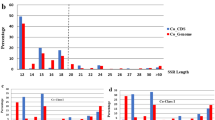Abstract
A consensus genetic map for chicory (2n = 2x = 18) was obtained after the integration of molecular marker data of two industrial chicory progenies (K28K59, Rubis118) and one witloof chicory progeny (BR). As a limited number of co-dominant markers was available at the beginning of this work, three different microsatellite-enriched libraries were produced from genomic DNA, resulting in 420, 719 and 1,251 sequences, respectively. The level of informative Simple Sequence Repeat (SSR) sequences from the three libraries ranged from 28 to 40%, thus defining a set of 730 SSR markers available for polymorphism screening. A subset of 81 Sequence-Tagged Sites (STS) developed from EST, cDNA, genes, and non-coding sequences was screened through Single Strand Conformational Polymorphism (SSCP) analysis, leading to 46 polymorphic loci integrated in the genetic maps. Markers were grouped and ordered on 9 homologous Linkage Groups (LG) for each of the three maps: 274 markers in K28K59, 282 markers in Rubis118, 178 markers in BR. Co-linear regions between maps were identified through 193 ‘bridge’ markers that allowed the integration of the 9 homologous LG in a consensus map containing 472 markers and covering 878 cM. Comparison across maps revealed the presence of 4 conserved regions with significant distorted markers, also defined as Segregation Distortion Regions (SDR), affected by gametic or zygotic selection factors. Marker distribution was not always uniform; 6 LG possessed homologous clustered regions in all maps. The consensus map could be the starting point for the identification and the cloning of major genes and QTL in fundamental and applied genetic areas in chicory.








Similar content being viewed by others
References
Andersen PS, Jespersgaard C, Vuust J, Christiansen M, Larsen LA (2003) High-throughput single strand conformation polymorphism mutation detection by automated capillary array electrophoresis: validation of the method. Hum Mutat 21:116–122
Areshchenkova T, Ganal MW (1999) Long tomato microsatellites are predominantly associated with centromeric regions. Genome 42:536–544
Armour JAL, Neumann R, Gobert S, Jeffreys AJ (1994) Isolation of human simple sequence repeat loci by hybridisation selection. Hum Mol Genet 3:599–605
Aubert G, Morin J, Jacquin F, Loridon K, Quillet M-C, Petit A, Rameau C, Lejeune-Hénaut I, Huguet T, Burstin J (2006) Functional mapping in pea, as an aid to the candidate gene selection and for investigating synteny with the model legume Medicago truncatula. Theor Appl Genet 112:1024–1041
Bannerot H, de Coninck B (1970) L’utilisation des hybrides F1: nouvelle méthode d’amélioration de la chicorée de Bruxelles. Symp. Int. Section Horticole d’Eucarpia. La chicorée de Bruxelles. Gembloux, Belgique, pp 99–118
Barcaccia G, Pallottini L, Soattin M, Lazzarin R, Parrini P, Lucchin M (2003) Genomic DNA fingerprints as a tool for identifying cultivated types of radicchio (Cichorium intybus L.) from Veneto, Italy. Plant Breed 122:178–183
Bellamy A, Vedel F, Bannerot H (1996) Varietal identification in Cichorium intybus L. and determination of genetic purity of F1 hybrid seed samples, based on RAPD markers. Plant Breed 115:128–132
Bremer K (1994) Asteraceae: cladistics and classification. Timber Press, Portland
Cervera M-T, Storme V, Ivens B, Gusmao J, Liu BH, Hostyn V, van Slycken J, van Montagu M, Boerjan W (2001) Dense genetic linkage maps of three Populus species (Populus deltoides, P. nigra and P. trichocarpa) based on AFLP and microsatellite markers. Genetics 158:787–809
Chakravarti A, Lasher LK, Reefer JE (1991) A maximum likelihood method for estimating genome length using genetic linkage data. Genetics 128:175–182
Chapman M, Chang J, Weisman D, Kesseli R, Burke J (2007) Universal markers for comparative mapping and phylogenetic analysis in the Asteraceae (Compositae). Theor Appl Genet 115:747–755
Cloutier S, Cappadocia M, Landry BS (1997) Analysis of RFLP mapping inaccuracy in Brassica napus L. Theor Appl Genet 95:83–91
Copenhaver GP, Nickel K, Kuromori T, Benito MI, Kaul S, Lin X, Bevan M, Murphy G, Harris B, Parnell LD, McCombie WR, Martienssen RA, Marra M, Preuss D (1999) Genetic definition and sequence analysis of Arabidopsis centromeres. Science 286:2468–2474
Dauchot N, Mingeot D, Purnelle B, Muys C, Watillon B, Boutry M, Van Cutsem P (2009) Construction of 12 EST libraries and characterization of a 12, 226 EST dataset for chicory (Cichorium intybus) root, leaves and nodules in the context of carbohydrate metabolism investigation. BMC Plant Biol 9:14
de Simone M, Morgante M, Lucchin M, Parrini P, Marocco A (1997) A first linkage map of Cichorium intybus L. using a one-way pseudo-testcross and PCR-derived markers. Mol Breed 3:415–425
Desprez FF, Bannerot H (1980) A study of pollen tube growth in witloof chicory. In: Maxon Smith JW, Langton A (eds) Proceedings Eucarpia meeting on leafy vegetables, Littlehampton, pp 47–52
Desprez B, Delesalle L, Dhellemmes C, Desprez M (1994) Genetics and breeding of industrial chicory. C R Acad Agric Fr 80:47–62
Dong F, Song J, Naess SK, Helgeson JP, Gebhardt C, Jiang J (2000) Development and applications of a set of chromosome-specific cytogenetic DNA markers in potato. Theor Appl Genet 101:1001–1007
Dujardin M, Louant BP, Tilquin JP (1979) Determining the caryogram of Cichorium intybus L. Ann Amélior Plantes 29:305–310
Eenink AH (1980) Breeding research on witloof chicory for the production of inbred lines and hybrids. In: Maxon Smith JW, Langton A (eds) Proceedings Eucarpia meeting on leafy vegetables, Littlehampton, pp 5–11
Eenink AH (1981) Compatibility and incompatibility in witloof-chicory (Cichorium intybus L.). 2. The incompatibility system. Euphytica 30:77–85
Eenink AH (1982) Compatibility and incompatibility in witloof-chicory (Cichorium intybus L.). 3. Gametic competition after mixed pollinations and double pollinations. Euphytica 31:773–786
Eujayl I, Sorrels M, Baum M, Wolters P, Powell W (2001) Assessment of genotypic variation among cultivated durum wheat based on EST-SSRs and genomic SSRs. Euphytica 119:39–43
Fishman L, Kelly AJ, Morgan E, Willis JH (2001) A genetic map in the Mimulus guttatus species complex reveals transmission ratio distortion due to heterospecific interactions. Genetics 159:1701–1716
Gautschi B, Tenzer I, Muller JP, Schmid B (2000a) Isolation and characterization of microsatellite loci in the bearded vulture (Gypaetus barbatus) and cross-amplification in three Old World vulture species. Mol Ecol 9:2193–2195
Gautschi B, Widmer A, Koella J (2000b) Isolation and characterization of microsatellite loci in the dice snake (Natrix tessellata). Mol Ecol 9:2192–2193
Glenn TC, Schable NA (2005) Isolating microsatellite DNA loci. Methods Enzymol 395:202–222
Gonzalo M, Oliver M, Garcia-Mas J, Monfort A, Dolcet-Sanjuan R, Katzir N, Arùs P, Monforte A (2005) Simple-sequence repeat markers used in merging linkage maps of melon (Cucumis melo L.). Theor Appl Genet 110:802–811
Grattapaglia D, Sederoff R (1994) Genetic linkage maps of Eucalyptus grandis and Eucalyptus urophylla using a pseudo-testcross: mapping strategy and RAPD markers. Genetics 137:1121–1137
Heesacker A, Kishore VK, Gao W, Tang S, Kolkman JM, Gingle A, Matvienko M, Kozik A, Michelmore RM, Lai Z, Rieseberg LH, Knapp SJ (2008) SSRs and INDELs mined from the sunflower EST database: abundance, polymorphisms, and cross-taxa utility. Theor Appl Genet 117:1021–1029
Hendriks T, Scheer I, Quillet M-C, Randoux B, Delbreil B, Vasseur J, Hilbert J-L (1998) A nonsymbiotic hemoglobin gene is expressed during somatic embryogenesis in Cichorium. Biochim Biophys Acta 1443:193–197
Hu J (2006) Defining the sunflower (Helianthus annuus L.) linkage group ends with the Arabidopsis-type telomere sequence repeat-derived markers. Chromosome Res 14:535–548
Jeuken M, van Wijk R, Peleman J, Lindhout P (2001) An integrated interspecific AFLP map of lettuce (Lactuca) based on two L. sativa × L. saligna F2 populations. Theor Appl Genet 103:638–647
Jones ES, Hughes LJ, Drayton MC, Abberton MT, Michaelson-Yeates TPT, Bowen C, Forster JW (2003) An SSR and AFLP molecular marker-based genetic map of white clover (Trifolium repens L.). Plant Sci 165:531–539
Kalo P, Endre G, Zimanyi L, Csanadi G, Kiss GB (2000) Construction of an improved linkage map of diploid alfalfa (Medicago sativa). Theor Appl Genet 100:641–657
Kaur N, Gupta AK (2002) Applications of inulin and oligofructose in health and nutrition. J Biosci 27:703–714
Kesseli RV, Paran I, Michelmore RW (1994) Analysis of a detailed genetic linkage map of Lactuca sativa (lettuce) constructed from RFLP and RAPD markers. Genetics 136:1435–1446
Kiers AM, Mes THM, vanderMeijden R, Bachmann K (2000) A search for diagnostic AFLP markers in Cichorium species with emphasis on endive and chicory cultivar groups. Genome 43:470–476
Kim J-S, Childs KL, Islam-Faridi MN, Menz MA, Klein RR, Klein PE, Price HJ, Mullet JE, Stelly DM (2002) Integrating karyotyping of sorghum by in situ hybridization of landed BACs. Genome 45:402–412
Koch G, Jung C (1997) Phylogenetic relationships of industrial chicory varieties revealed by RAPDs and AFLPs. Agronomie 17:323–333
Korbecka G, Klinkhamer PGL, Vrieling K (2002) Selective embryo abortion hypothesis revisited – a molecular approach. Plant Biol 4:298–310
Kosambi DD (1944) The estimation of map distance from recombination values. Ann Eug 12:172–175
Lange K, Boehnke M (1982) How many polymorphic genes will it take to span the human genome? Am J Hum Genet 34:842–845
Lashermes P, Combes M-C, Prakash NS, Trouslot P, Lorieux M, Charrier A (2001) Genetic linkage map of Coffea canephora: effect of segregation distortion and analysis of recombination rate in male and female meioses. Genome 44:589–596
Laurent V, Devaux P, Thiel T, Viard F, Mielordt S, Touzet P, Quillet M-C (2007) Comparative effectiveness of sugar beet microsatellite markers isolated from genomic libraries and GenBank ESTs to map the sugar beet genome. Theor Appl Genet 115:793–805
Legrand S, Hendriks T, Hilbert J-L, Quillet M-C (2007) Characterization of expressed sequence tags obtained by SSH during somatic embryogenesis in Cichorium intybus L. BMC Plant Biol 7:27
Li G, Kemp PD (2005) Forage chicory (Cichorium intybus L.): a review of its agronomy and animal production. In: Sparks DL (ed) Advances in agronomy, vol 88. Academic Press, London, pp 187–222
Lorieux M, Perrier X, Goffinet B, Lanaud C, Gonzales de Leon D (1995) Maximum-likelihood models for mapping genetic markers showing segregation distortion. 2. F2 populations. Theor Appl Genet 90:81–89
Lu H, Romero-Severson J, Bernardo R (2002) Chromosomal regions associated with segregation distortion in maize. Theor Appl Genet 105:622–628
Lucchin M, Varotto S, Barcaccia G, Parrini P (2008) Chicory and endive. In: Prohen J, Nuez F (eds) Vegetables I. Springer, New York, pp 3–48
Luce AC, Sharma A, Mollere OSB, Wolfgruber TK, Nagaki K, Jiang J, Presting GG, Dawe RK (2006) Precise centromere mapping using a combination of repeat junction markers and chromatin immunoprecipitation—polymerase chain reaction. Genetics 174:1057–1061
Maliepaard C, Jansen J, van Ooijen JW (1997) Linkage analysis in a full-sib family of an outbreeding plant species: overview and consequences for applications. Genet Res 70:237–250
Morgante M, Olivieri A (1993) PCR-amplified microsatellites as markers in plant genetics. Plant J 3:175–182
Panero JL, Funk VA (2002) Toward a phylogenetic subfamilial classification for the Compositae. Proc Biol Soc Wash 115:909–922
Pécaut P (1962) Etude sur le système de reproduction de l’endive (Cichorium intybus L.). Ann Amélior Plantes 12:265–296
Pool-Zobel BL (2005) Inulin-type fructans and reduction in colon cancer risk: review of experimental and human data. Br J Nutr 93:S73–S90
Pouilly N, Delourme R, Alix K, Jenczewski E (2008) Repetitive sequence-derived markers tag centromeres and telomeres and provide insights into chromosome evolution in Brassica napus. Chromosome Res 16:683–700
Rambaud C, Dubois J, Vasseur J (1993) Male-sterile chicory cybrids obtained by intergeneric protoplast fusion. Theor Appl Genet 87:347–352
Ramsay L, Macaulay M, Cardle L, Morgante M, Ivanissevich SD, Maestri E, Powell W, Waugh R (1999) Intimate association of microsatellite repeats with retrotransposons and other dispersed repetitive elements in barley. Plant J 17:415–425
Ramsay L, Macaulay M, Ivanissevich SD, MacLean K, Cardle L, Fuller J, Edwards KJ, Tuvesson S, Morgante M, Massari A, Maestri E, Marmiroli N, Sjakste T, Ganal M, Powell W, Waugh R (2000) A simple sequence repeat-based linkage map of barley. Genetics 156:1997–2005
Remington DL, Whetten RW, Liu B-H, O’Malley DM (1999) Construction of an AFLP genetic map with nearly complete genome coverage in Pinus taeda. Theor Appl Genet 98:1279–1292
Rick CM (1953) Hybridization between chicory and endive. J Am Soc Hort Sci 61:459–466
Rungis D, Bérubé Y, Zhang J, Ralph S, Ritland CE, Ellis BE, Douglas C, Bohlmann J, Ritland K (2004) Robust simple sequence repeat markers for spruce (Picea spp.) from expressed sequence tags. Theor Appl Genet 109:1283–1294
Schmidt T, Jung C, Metzlaff M (1991) Distribution and evolution of two satellite DNAs in the genus Beta. Theor Appl Genet 82:793–799
Song X-L, Sun X-Z, Zhang T-Z (2006) Segregation distortion and its effect on genetic mapping in plants. Chin J Agric Biotechnol 3:163–169
Squirrell J, Hollingsworth PM, Woodhead M, Russell J, Lowe AJ, Gibby M, Powell W (2003) How much effort is required to isolate nuclear microsatellites from plants? Mol Ecol 12:1339–1348
Tang S, Yu J-K, Slabaugh M, Shintani D, Knapp S (2002) Simple sequence repeat map of the sunflower genome. Theor Appl Genet 105:1124–1136
Torjek O, Witucka-Wall H, Meyer R, von Korff M, Kusterer B, Rautengarten C, Altmann T (2006) Segregation distortion in Arabidopsis C24/Col-0 and Col-0/C24 recombinant inbred line populations is due to reduced fertility caused by epistatic interaction of two loci. Theor Appl Genet 113:1551–1561
van Cutsem P, du Jardin P, Boutte C, Beauwens T, Jacqmin S, Vekemans X (2003) Distinction between cultivated and wild chicory gene pools using AFLP markers. Theor Appl Genet 107:713–718
van Ooijen JW, Voorrips RE (2001) JoinMap 3.0, software for the calculation of genetic linkage maps. Plant Research International, Wageningen
van Stallen N, Noten V, Demeulemeester M, de Proft M (2000) Identification of commercial chicory cultivars for hydroponic forcing and their phenetic relationships revealed by random amplified polymorphic DNAs and amplified fragment length polymorphisms. Plant Breed 119:265–270
van Stallen N, Vandenbussche B, Verdoodt V, de Proft M (2003) Construction of a genetic linkage map for witloof (Cichorium intybus L. var. foliosum Hegi). Plant Breed 122:521–525
van Stallen N, Vandenbussche B, Londers E, Noten V, de Proft M (2005a) QTL analysis of important pith characteristics in a cross between two inbred lines of chicory (Cichorium intybus var. foliosum): a preliminary study. Plant Breed 124:54–58
van Stallen N, Vandenbussche B, Londers E, Noten V, de Proft M (2005b) QTL analysis of production and taste characteristics of chicory (Cichorium intybus var. foliosum). Plant Breed 124:59–62
Varotto S, Pizzoli L, Lucchin M, Parrini P (1995) The incompatibility system in Italian red chicory (Cichorium intybus L.). Plant Breed 114:535–538
Varshney RK, Graner A, Sorrells ME (2005) Genic microsatellite markers in plants: features and applications. Trends Biotechnol 23:48–55
Voorrips RE (2002) MapChart: software for the graphical presentation of linkage maps and QTLs. J Hered 93:77–78
Wang K, Guo W, Zhang T (2007) Development of one set of chromosome-specific microsatellite-containing BACs and their physical mapping in Gossypium hirsutum L. Theor Appl Genet 115:675–682
Wittop Koning DA, Leroux A (1972) La chicorée dans l’histoire de la médecine et dans la céramique pharmaceutique. Rev Hist Pharm (Suppl) 215: 28 p
Yan Z, Denneboom C, Hattendorf A, Dolstra O, Debener T, Stam P, Visser PB (2005) Construction of an integrated map of rose with AFLP, SSR, PK, RGA, RFLP, SCAR and morphological markers. Theor Appl Genet 110:766–777
Yu J-K, Tang S, Slabaugh MB, Heesacker A, Cole G, Herring M, Soper J, Han F, Chu W-C, Webb DM, Thompson L, Edwards KJ, Berry S, Leon AJ, Grondona M, Olungu C, Maes N, Knapp SJ (2003) Towards a saturated molecular genetic linkage map for cultivated sunflower. Crop Sci 43:367–387
Zane L, Bargelloni L, Patarnello T (2002) Strategies for microsatellite isolation: a review. Mol Ecol 11:1–16
Acknowledgments
The present work was financed by a public–private partnership ‘Groupement d’Intérêt Scientifique’ CARTOCHIC involving UMR 1281 SADV, Université de Lille 1, Florimond Desprez Veuve and Fils SAS, Leroux SAS, and SARL Hoquet Endives. We would like to thank Louis Delesalle, Jean-Christophe Lepeltier, Pierre Devaux (Florimond-Desprez) and Pascal Lévêque (Hoquet Endives) who have generated and maintained the Rubis118 and BR populations. We also acknowledge the SREL laboratory of Dr Travis Glenn (Travis Glenn, Cris Hagen, Lucy Dueck, SREL, Aitken, SC, USA) for the training at the first authors in the SSR enrichment protocol, and Aude Darracq (UMR 8016 GEPV, Université de Lille 1) for the development of a program devoted to the identification of unique SSR sequences. Helpful comments and critical reading of the manuscript by Bruno Desprez and Pierre Devaux have also been greatly appreciated.
Author information
Authors and Affiliations
Corresponding author
Additional information
Thierry Cadalen and Monika Mörchen contributed equally to this work.
Rights and permissions
About this article
Cite this article
Cadalen, T., Mörchen, M., Blassiau, C. et al. Development of SSR markers and construction of a consensus genetic map for chicory (Cichorium intybus L.). Mol Breeding 25, 699–722 (2010). https://doi.org/10.1007/s11032-009-9369-5
Received:
Accepted:
Published:
Issue Date:
DOI: https://doi.org/10.1007/s11032-009-9369-5




